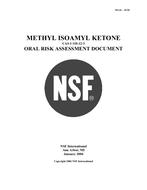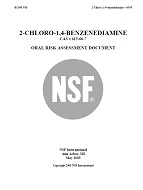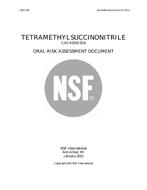Customers Who Bought This Also Bought
-

NSF MIAK-04
Priced From $55.00 -

NSF 2-Chloro-1,4-Benzenediamine-05
Priced From $55.00 -

NSF Tetramethylsuccinonitrile - 2011
Priced From $55.00 -

NSF P-Tert-Butylphenol - 2020
Priced From $55.00
About This Item
Full Description
Abstract:
Human exposure to bisphenol A (BPA) is due to that found in the diet, and BPA and its metabolites were detected at parts per billion (or less) concentrations in human urine, milk, saliva, serum, plasma, ovarian follicular fluid, and amniotic fluid. Adverse health effects in mice and rats may be induced after parenteral injection or after massive oral doses. Controlled ingestion trials in healthy adult volunteers with 5 mg d16-BPA were unable to detect parent BPA in plasma despite exquisitely sensitive (limit of detection = 6 nM) methods, but by 96 h 100% of the administered dose was recovered in urine as the glucuronide. The extensive BPA glucuronidation following ingestion is not seen after parenteral injection; only the parent BPA binds plasma proteins and estrogen receptors (ER). The hypothesis that BPA dose-response may be described by a J- or U-shape curve was not supported by toxicogenomic data collected in fetal rat testes and epididymes (after repeated parenteral exposure at 2-400,000 g/kg-d), where a clear monotonic dose-response both in the numbers of genes and magnitude of individual gene expression was evident. There is no clear indication from available data that the BPA doses normally consumed by humans pose an increased risk for immunologic or neurologic disease. There is no evidence that BPA poses a genotoxic or carcinogenic risk and clinical evaluations of 205 men and women with high-performance liquid chromatography (HPLC)-verified serum or urinary BPA conjugates showed (1) no objective signs, (2) no changes in reproductive hormones or clinical chemistry parameters, and (3) no alterations in the number of children or sons:daughters ratio. Results of benchmark dose (BMD10 and BMDL10) calculations and no-observed-adverse-effect level (NOAEL) inspections of all available and reproducible rodent studies with oral BPA found BMD and NOAEL values all greater than the 5 mg/kg-d NOAELs from mouse and rat multigeneration reproduction toxicity studies. While allometric and physiologically based pharmacokinetic (PBPK) models were constructed for interspecies scaling of BPA and its interaction with ER, multigeneration feeding studies with BPA at doses spanning 5 orders of magnitude failed to identify signs of developmental toxicity or adverse changes in reproductive tract tissues; the 5-mg/kg-d NOAELs identified for systemic toxicity in rats and mice were less than the oral NOAELs for reproductive toxicity. Thus, it is the generalized systemic toxicity of ingested BPA rather than reproductive, immunologic, neurobehavioral, or genotoxic hazard that represents the point of departure. Using U.S. Environmental Protction Agency (EPA) uncertainty factor guidance and application of a threefold database uncertainty factor (to account for the fact that the carcinogenic potential of transplacental BPA exposure has yet to be fully defined and comprehensive neurobehavioral and immunotoxicologic evaluations of BPA by relevant routes and at relevant doses have yet to be completed) to the administered dose NOAEL results in an oral RfD of 0.016 mg/kg-d. Assuming the 70-kg adult consumes 2 L of water each day and adopting the default 20% U.S. EPA drinking water relative source contribution yields a 100 g/L BPA total allowable concentration (TAC).





